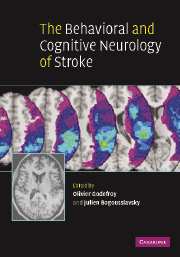Book contents
- Frontmatter
- Contents
- Contributors
- Preface
- 1 Evaluation of cognitive and behavioral disorders in the stroke unit
- Motor and gestural disorders
- Aphasia and arthric disorders
- Hemineglect, Anton–Babinski and right hemisphere syndromes
- Agnosia and Bálint's syndrome
- Executive and memory disorders
- Behavioral and mood disorders
- 22 Akinetic mutism and related disorders
- 23 Alterations of level of consciousness related to stroke
- 24 Delirium and confusional state in stroke patients
- 25 Post-stroke delusion
- 26 Acute behavioral and mood changes
- 27 Stroke and personality change
- 28 Post-stroke mania
- 29 Depression after stroke
- 30 Fatigue
- Dementia and anatomical left/right syndromes
- Index
- References
25 - Post-stroke delusion
Published online by Cambridge University Press: 10 October 2009
- Frontmatter
- Contents
- Contributors
- Preface
- 1 Evaluation of cognitive and behavioral disorders in the stroke unit
- Motor and gestural disorders
- Aphasia and arthric disorders
- Hemineglect, Anton–Babinski and right hemisphere syndromes
- Agnosia and Bálint's syndrome
- Executive and memory disorders
- Behavioral and mood disorders
- 22 Akinetic mutism and related disorders
- 23 Alterations of level of consciousness related to stroke
- 24 Delirium and confusional state in stroke patients
- 25 Post-stroke delusion
- 26 Acute behavioral and mood changes
- 27 Stroke and personality change
- 28 Post-stroke mania
- 29 Depression after stroke
- 30 Fatigue
- Dementia and anatomical left/right syndromes
- Index
- References
Summary
Introduction
Delusion is defined as strongly held and often bizarre beliefs whose acceptance and subsequent behavior can constitute the grounds for insanity. The patient with delusion is considered to have lost touch with reality. Delusional ideation may concern one or more of the following themes: grandiosity, jealousy, persecutory thoughts, erotomania. Delusional states that are fully experienced by the subject are accompanied by various affective and behavioral symptoms such as emotionalism, negativism, dysphoria, aggressiveness, hostility, agitation, or anxiety reaction.
There are several monothematic delusions like somatic delusion (hypochondria), delusional parasitosis, belief that the skin is infested with worms, insects, or organisms, Cotard's syndrome, belief in the loss of a body organ, or the belief of being dead – Fregoli's or Capgras' delusion. Detailed investigations of such monodelusional conditions can help to generate testable theories of delusion, face recognition and normal belief formation in cognitive neuropsychiatry (Ellis and Lewis, 2001).
Acute and chronic delusions are a core symptom of several psychiatric disorders (schizophrenia, paranoia, paraphrenia, schizoaffective disorders) and they may sometimes appear during the acute phase of non-psychotic disorder. Since the nineteenth century, it has been acknowledged that psychotic mental disorders characterized by delusions or hallucinations may develop as the physiological result of various brain diseases or general medical illnesses. The DSM-IV RT defines the criteria of “Psychotic disorder due to a general medical condition” (Table 25.1). Two subtypes are proposed according to the prominence of delusion or hallucination.
- Type
- Chapter
- Information
- The Behavioral and Cognitive Neurology of Stroke , pp. 510 - 519Publisher: Cambridge University PressPrint publication year: 2007
References
- 1
- Cited by



